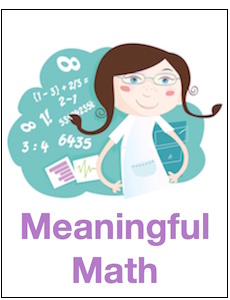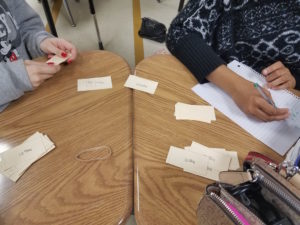3 Activities I’ve Used to Engage Math Students
A MiddleWeb Blog
 My idea of good teaching has changed dramatically in 16 years. I was firmly in the compliance corner when I started teaching. If students were quiet and mimicking good behavior, I thought they were learning. That was a hard lesson for me to unlearn.
My idea of good teaching has changed dramatically in 16 years. I was firmly in the compliance corner when I started teaching. If students were quiet and mimicking good behavior, I thought they were learning. That was a hard lesson for me to unlearn.
This year I have been trying to think about how to achieve real engagement with every lesson, which is rarely a quiet process. It can be daunting at times. How do you encourage 26 students after lunch or after a long weekend to be engaged in their lesson? Fully engaged, 100%. I am not convinced it’s possible, 100% of students, 100% of the time.
But I always think I can do better, so I am trying different strategies and structures to see what works with my students. Here are the activities I have used so far to try to encourage more engagement in my classroom. I’ve included my notes on the outcomes I’ve observed and added an engagement scale beside each activity (1 star least; 5 stars most).
 Speed Dating
Speed Dating
I have done this from time to time over the years. I just recently used it with my Algebra II classes. The set-up: I created 24 math problems on our current topic (evaluating rational expressions) and 2 questions that weren’t math related (how was your Thanksgiving Break and what are you looking forward to on your Christmas break).
Each problem and question was written on an index card with the answer on the back (covered up with a small post it note). Students were given a blank piece of paper to write the problems on. I put my 26 students in pairs and labeled the desks A through M (one desk had no letter).

The students then swap problems with their partners. If a student needs help, the person next to them is the “expert.” After they work the problem and check their answer, they swap back cards so that every person has their original card. I call time when I observe that the students have completed the round.
Then the students who have a letter on their desk move to the next letter of the alphabet, a moves to b and so on. (The student with no letter on their desk remains seated.) They sit down with their new partner and swap cards and work their new problem. When they finish, they swap back so that they have their original card. This repeats until you run out of time.
At the end of the activity I asked each student to write the name of the person who was the best “expert” on their paper. The best “expert” is the person who was the most patient, gave good explanations, and in general tried to be helpful. From each class the top 3 vote getters will get stamps or stickers.

I got some work from every student. That alone is worthwhile. In most classes, all the students worked on every problem. I heard many good explanations. I think the students who were more willing to be experts got a lot out of this activity. They certainly understood their problem very well by the end of the activity. I could tell that some students were pleased to be chosen as the best “expert.”
►Cons
Some students just wanted to look at the answer on the back of the card and not do any work. Some students looked at the answer and worked backwards, which I am ok with. I am debating about putting the answer on the back of the card next time, but in a big class it saves so much time.
A few students are really introverted and struggled with the activity (I would say 3 or 4 out of the whole day). Even with the activity some students were off task. I think that this activity works much better in a class with 20 students or less – it’s just more manageable.
In conclusion, I would do this activity again. It is a good activity for getting the students moving, I did this the day we came back from Thanksgiving Break, and I don’t think I would have gotten much engagement without this activity.
 Bingo from Lecture
Bingo from Lecture
In my AP Statistics class I have to lecture at times. I don’t want students to drift off so I have been looking for ways to up engagement during lectures. I recently tried “Notes Bingo.” Set up: I came up with 8 questions and gave students a 3×3 bingo card (1 free space). Each space addressed a question that could be answered from the lecture.
I went to a free website – myfreebingocards – that created 30 different cards. As the class progressed, students filled in their Bingo card. The first person to get a “Bingo” received 3 stamps. At the end of the class, everyone who had all spaces filled in received a stamp. I got the idea from Science of Curiosity.
►Pros
One student said, “I actually learned something today.” Every student did some work. It actually reinvigorated my classes. I was surprised how much they enjoyed it.
►Cons
It was difficult to think of prompts that would fit on the Bingo card. This activity does not guarantee a deep understanding – it just makes sure that students are paying attention and taking notes. I haven’t quite worked the kinks out of how to handle lesson interruptions when a student bingos. Maybe I could give out the bingo cards at the end, have them put their notes away, and try to get a bingo by answering the prompts from memory?
This is definitely an activity I will do again!
 Vertical Learning for ACT Prep (Bellringer)
Vertical Learning for ACT Prep (Bellringer)
This activity has required the least time to prep and has paid the most dividends. The setup: Place ACT packets (math section) at various places on the whiteboard. Number students as they come in – I number mine 1 to 5. All the 1’s go to the 1’s area on the whiteboard and so forth. They have different numbers and partners every day. When they get to the whiteboard, every group works the same problem from the packet.

More students are actually doing the bellringer. I can immediately look around and see who has it right, common errors, and so forth. Students are talking to each other about math. Today I heard, “Do you think we should subtract and divide by 5?” Another student said, “I don’t know, but let’s find out.” I do not get those conversations when they are not at the board working.
►Cons
Some students have the tendency to always take the lead working the problem, and other students tend to always stay back. Changing groups every day helps with this problem but does not eliminate it. I have been trying to encourage different students to take the lead, I might have to make it more structured and give students rotating roles, but I have held off so far just so I can see how things go. Students grumble every day when I number them off, but they do it anyway!
Engagement is hard
When I plan my lessons, I now think about how I can structure things so that every student is engaged. I won’t lie – it’s hard. It’s so much easier to just put the information out there and expect them to get it. Putting structures in place that encourage engagement takes more time and a lot more forethought. Sometimes the activities work great, and sometimes they fall flat.
But I still believe a louder, more talkative class that is somewhat engaged in the concept is better than a quiet one. So I will continue to look for ways to encourage my students to get involved with the content. If you have any strategies or structures that have worked in your class, please share them in the comments below!





























